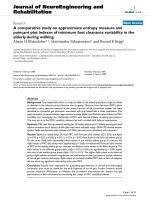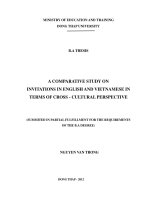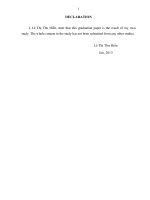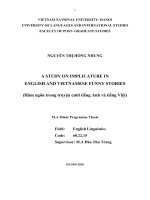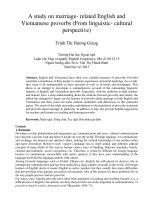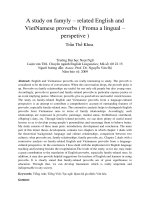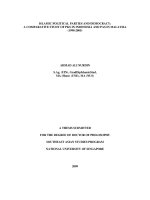A comparative study on apologizing in english and vietnamese conversations
Bạn đang xem bản rút gọn của tài liệu. Xem và tải ngay bản đầy đủ của tài liệu tại đây (1.49 MB, 115 trang )
MINISTRY OF EDUCATION AND TRAINING
QUY NHON UNIVERSITY
BUI THI LE SUONG
A COMPARATIVE STUDY ON APOLOGIZING IN
ENGLISH AND VIETNAMESE CONVERSATIONS
Field: English Linguistics
Code: 8220201
Supervisor: Truong Van Dinh, PhD
Binh Dinh - 2023
BỘ GIÁO DỤC VÀ ĐÀO TẠO
TRƯỜNG ĐẠI HỌC QUY NHƠN
BÙI THỊ LỆ SƯƠNG
NGHIÊN CỨU ĐỐI CHIẾU PHÁT NGÔN XIN LỖI
TRONG HỘI THOẠI ANH - VIỆT
Ngành: Ngôn ngữ Anh
Mã số: 8220201
Người hướng dẫn: TS. Trương Văn Định
Bình Định - 2023
i
STATEMENT OF AUTHORSHIP
I certify that this master thesis entitled “A Comparative Study on Apologizing in
English and Vietnamese Conversations” is ultimately my own original work. To the
best of my knowledge, this thesis has not been submitted for any purposes in any
materials. Any works of other authors consulted in this thesis are listed in the
reference.
Binh Dinh, 2023
BUI THI LE SUONG
ii
ACKNOWLEDGEMENTS
This thesis would not have been accomplished in time without the massive
contribution of all individuals involved.
Firstly, I owe many thanks to my supervisor, Dr. Trương Văn Định, who
devoted his time and effort to guiding and giving me invaluable support despite his
vast workload and busy schedule. Without his enthusiasm and encouragement, I
might not have finished my master’s thesis.
Secondly, I truly appreciate all the lecturers from Quy Nhon University
(QNU), especially Assoc. Prof., Dr. Nguyễn Thị Thu Hiền, and others, for their
wholehearted contribution to sharpening my academic knowledge during the course.
Thirdly, I would like to sincerely thank the Department of Postgraduate
Training and the Department of Foreign Languages of QNU for the cooperation and
support.
Last but not least, I am immensely grateful to my husband, who has given me
considerable support and motivation so that I could wholeheartedly concentrate on
my thesis. My honest thanks will be sent to my classmates and many others, who
supported me while I was carrying out this thesis.
Binh Dinh, 2023
iii
ABSTRACT
This thesis delves into a detailed cross-cultural examination, specifically
targeting the nuances of apology strategies within English and Vietnamese contexts.
With data comprising 50 diverse utterances from each linguistic backdrop, the
research discerns both universal constants and culturally distinct nuances in the
approach to apologizing. Notably, while English utterances tend to prefer direct
apologies, Vietnamese counterparts often seek forgiveness, perhaps reflecting
societal values of humility and indirectness.
The analysis also reveals distinct linguistic and cultural trends in the use of
modality markers. Vietnamese dialogues exhibit a pronounced use of politeness
markers, potentially influenced by societal values rooted in respect and possibly even
Confucian philosophy. Yet, despite these variations, certain conversational strategies
appear universally adopted across both languages, suggesting shared human
conversational tendencies.
The implications of this study span enhancing cross-cultural interactions and
pedagogical advancements. Firstly, the findings illuminate pathways to improved
intercultural communication by promoting understanding, empathy, and reduced
misunderstandings. In educational settings, the insights provide teachers and
curriculum designers tools to amplify language instruction with cultural contexts,
fostering appreciation and practical life skills for learners.
However, a notable limitation is the data set's limited scope. Additionally,
sourcing predominantly from cinematic dialogues might not always encapsulate the
genuine subtleties of day-to-day conversations.
Future research includes expanding data sources, considering cultural roots
influencing apology strategies, and widening the linguistic scope to include other
languages, furthering the understanding of global conversational norms. This
research, thus, serves as both a foundational study and a launchpad for more extensive
explorations in the realm of cross-cultural communication.
iv
TABLES OF CONTENTS
STATEMENT OF AUTHORSHIP ......................................................................... i
ACKNOWLEDGEMENTS..................................................................................... ii
ABSTRACT ............................................................................................................. iii
LIST OF ABBREVIATIONS............................................................................... viii
LIST OF TABLES .................................................................................................. ix
LIST OF FIGURES ..................................................................................................x
CHAPTER ONE. INTRODUCTION .....................................................................1
1.1. Rationale ..........................................................................................................1
1.2. Aim and Objectives of the Study ...................................................................2
1.2.1. Aim of the Study ........................................................................................2
1.2.2. Objectives of the Study ..............................................................................2
1.3. Research Questions.........................................................................................2
1.4. Scope of the Study...........................................................................................3
1.5. Significance of the Study ................................................................................3
1.6. Organization of the Study ..............................................................................3
CHAPTER TWO. LITERATURE REVIEW ........................................................5
2.1. Theoretical Background.................................................................................5
2.1.1. Speech Act..................................................................................................5
2.1.1.1. Definition of Speech Act....................................................................5
2.1.1.2. Classification of Speech Act..............................................................7
2.1.2. Politeness .................................................................................................11
2.1.2.1. Definition of Politeness ...................................................................12
2.1.2.2. Politeness Strategies .......................................................................15
2.1.3. Politeness - Directness - Indirectness in Apologizing............................25
2.1.4. Apology Strategies ...................................................................................27
v
2.1.4.1. Apology Strategies by Blum-Kulka and Olshtain ...........................27
2.1.4.2. Apology Strategies by Fraser..........................................................28
2.1.4.3. Apology Strategies by Holmes ........................................................29
2.1.5. Cross-cultural Communication ..............................................................32
2.1.5.1. Definition of Communication..........................................................32
2.1.5.2. Politeness in Vietnamese Culture....................................................33
2.1.5.3. Politeness in Anglo-American Culture ...........................................33
2.1.6. Theory of Modality ..................................................................................34
2.1.6.1. Definition of Modality .....................................................................34
2.1.6.2. Classification of Modality Markers in Conversations ....................36
2.2. Previous Studies ............................................................................................39
CHAPTER THREE. RESEARCH METHODOLOGY......................................46
3.1. Research Methods.........................................................................................46
3.2. Data Description ...........................................................................................46
3.2.1. English Movies ........................................................................................48
3.2.2. Vietnamese Movies ..................................................................................48
3.3. Data Analysis.................................................................................................49
3.4. Research Procedures ....................................................................................51
CHAPTER FOUR. FINDINGS AND DISCUSSION ..........................................53
4.1. Apology Strategies in English and Vietnamese..........................................53
4.1.1. Apology Strategies in English .................................................................53
4.1.1.1. An Explicit Expression of Apology..................................................54
4.1.1.2. Explanation or Account...................................................................56
4.1.1.3. Acknowledgment of Responsibility..................................................57
4.1.1.4. Promise of Forbearance .................................................................57
4.1.2. Apology Strategies in Vietnamese...........................................................58
4.1.2.1. An Explicit Expression of Apology..................................................60
vi
4.1.2.2. Explanation or Account...................................................................61
4.1.2.3. Acknowledgment of Responsibility..................................................62
4.1.2.4. Promise of Forbearance .................................................................64
4.1.3. Similarities and Differences in Apology Strategies in English and
Vietnamese .........................................................................................................65
4.1.3.1. An Explicit Expression of Apology..................................................66
4.1.3.2. Explanation or Account...................................................................67
4.1.3.3. Acknowledgment of Responsibility..................................................67
4.1.3.4. Promise of Forbearance .................................................................68
4.2. Modality Markers in Apology Utterances in English and Vietnamese ...69
4.2.1. Modality Markers in Apology Utterances in English ............................69
4.2.1.1. Downgraders...................................................................................71
4.2.1.2. Upgraders .......................................................................................73
4.2.2. Modality Markers in Apology Utterances in Vietnamese ......................75
4.2.2.1. Downgraders...................................................................................76
4.2.2.2. Upgraders .......................................................................................80
4.2.3. Similarities and Differences in Modality Markers in English and
Vietnamese .........................................................................................................81
4.2.3.1. Downgraders...................................................................................83
4.2.3.2. Upgraders .......................................................................................84
CHAPTER FIVE. CONCLUSION .......................................................................87
5.1. Conclusion .....................................................................................................87
5.2. Implications ...................................................................................................88
5.2.1. Enhanced Cross-Cultural Communication: ..........................................88
5.2.2. Pedagogical Implications ........................................................................88
5.3. Limitations.....................................................................................................89
5.4. Suggestions for Further Research ...............................................................89
vii
REFERENCES ........................................................................................................92
APPENDICES .........................................................................................................95
APPENDIX A.......................................................................................................95
APPENDIX B .....................................................................................................101
QNU viii
EU
VU LIST OF ABBREVIATIONS
Quy Nhon University
English Utterance
Vietnamese Utterance
ix
LIST OF TABLES
Table Title Page
number number
Table 4.1. Frequency and Distribution of Apology Strategies in
Table 4.2. English 59
Table 4.3. 64
Table 4.4. Frequency and Distribution of Apology Strategies in 70
Vietnamese 75
Table 4.5.
Frequency and Distribution of Apology Strategies in 80
Table 4.6. English and Vietnamese Utterances
87
Frequency and Distribution of Modality Markers in
English
Frequency and Distribution of Modality Markers in
Vietnamese
Frequency and Distribution of Modality Markers in
English and Vietnamese
Figure x Page
number number
LIST OF FIGURES
Figure 2.1. 22
Title
Chart of Strategies: Negative Politeness
1
CHAPTER ONE. INTRODUCTION
1.1. Rationale
Effective communication is akin to an art form, where conversationalists are
artists creating dialogic masterpieces. In all facets of life, adept communication skills
are not just preferable but are prerequisites for building successful relationships and
navigating cultural norms. Regardless of geographical or cultural contexts - be it
Western societies or Vietnam, real-life interactions or filmic representations - the
quality of communication can be a determinant for the success or failure of
relationships.
In a world that is replete with human imperfections, apology comes to the fore
as a necessary tool in maintaining social harmony. As highlighted by North-Holland
(1987), when a person’s action, utterance, or lack thereof offends another and they
are deemed accountable, an apology is warranted. This act of apologizing
encompasses not just the words expressed but also the intent to rectify the wrong, to
mend what has been fractured in the relationship. The nature and delivery of such
apologies vary depending on the relationship’s intimacy and cultural contexts,
demonstrating the nuances of this communicative act.
In the contemporary digital age, marked by advanced 4.0 technologies,
societal evolution is mirrored by growing demands for online entertainment. As such,
real-life conversations and societal norms are increasingly being documented and
globalized to cater to this evolving need for virtual connectedness.
The importance of apologies in English and Vietnamese dialogues has been
acknowledged and extensively studied by many researchers worldwide. Yet, there
remains a conspicuous gap in literature pertaining to the specific utterances of
apologies in English-Vietnamese conversations. This is crucial to attain a
comprehensive understanding of cross-cultural communication between English and
Vietnamese speakers and to cultivate effective English teaching methodologies based
on a communicative approach.
2
To bridge this knowledge gap, I have undertaken this cross-cultural study titled
“A Comparative Study on Apologizing in English and Vietnamese Conversations”
for my master's thesis. The aim of this research is to explore the cultural similarities
and differences between English and Vietnamese apologizing practices, with a
particular focus on filmic conversations.
By contributing to our understanding of effective cross-cultural
communication, it is my hope that this study will enhance the portrayal of real-life
interactions in films and improve the teaching and learning methodologies of English.
1.2. Aim and Objectives of the Study
1.2.1. Aim of the Study
The aim of the study is to investigate the similarities and differences in
apologies in English and Vietnamese conversations in terms of apology strategies and
modality markers.
1.2.2. Objectives of the Study
The following detailed objectives are set to ensure the implementation of the
above aim:
- To explore the apology strategies in English and Vietnamese
conversations.
- To identify the use of modality markers in apology utterances in English-
Vietnamese conversations.
- To find out the similarities and differences in the use of apology strategies
and modality markers in English and Vietnamese conversations.
1.3. Research Questions
In order to achieve the aim and objectives of the study, the following research
questions will be applied:
1. What apology strategies are used in English and Vietnamese conversations?
2. What modality markers are used in apology utterances in English and
Vietnamese conversations?
3. What are the similarities and differences in the use of apology strategies and
modality markers in English and Vietnamese conversations?
3
1.4. Scope of the Study
This study concentrates solely on apology utterances in English and
Vietnamese conversations based on the theoretical framework of Holmes (1990) and
House and Kasper (2012) and will not include the following aspects:
Firstly, it does not address paralinguistic and extralinguistic factors. Although
these factors are crucial in communication, there is limited consensus among linguists
regarding these issues.
Secondly, this study does not differentiate between American English and
British English. Both variations of English are treated with equal relevance.
Thirdly, owing to resource and time constraints, this research focuses on
apology utterances in movies, utilizing multiple films in each category, rather than
on response utterances.
Finally, while acknowledging the significance of factors such as age, gender,
social status, and the relationship between interlocutors - as they impact the politeness
strategies employed by the speaker - these elements are outside the purview of this
study due to limitations in time and research capacity.
1.5. Significance of the Study
Theoretically, first, this study underscores the significance of culture in verbal
behaviors, contributing to the exploration of speech acts within the framework of
pragmatics and linguistic politeness. Second, by applying the insights gained from
both domestic and international language theories, this investigation of the strategies
used in apologies will contribute to the preservation of the integrity of the Vietnamese
language.
Practically, the findings of this study will highlight notable similarities and
differences in apologies as depicted in English and Vietnamese films. Consequently,
this research will greatly assist directors and producers of English and Vietnamese
films, as well as viewers, by equipping them with a solid understanding of the apology
utterances. This understanding will help to optimize communication effectiveness
and mitigate culture shock in cross-cultural interactions.
1.6. Organization of the Study
4
The study is divided into five chapters:
Chapter 1, Introduction, presents the rationale, aim, objectives, scope of the
study, significance, research questions, methods, and organization of the study.
Chapter 2, Literature Review, presents a theory of politeness and modality.
This chapter also provides the theoretical background of negative politeness
strategies, i.e. apology strategy in English and Vietnamese.
Chapter 3, Methods and Procedures, presents the research methods of the
study, data collection, and data analysis.
Chapter 4, Findings and Discussion, presents the results gained in the
processing of the data and discusses the results of the data analysis.
Chapter 5, Conclusion, summarizes the findings recorded during making this
study, presents the constraints of the study, provides some suggestions for further
study, and gives implications on teaching and learning.
5
CHAPTER TWO. LITERATURE REVIEW
This chapter provides a review of the thesis’s theoretical background. We
begin with the leading academic theories on which this study is based. Next, we
provide a theoretical framework for the method of analysis conducted in the present
study, including the theories of apology strategies and modality, which will be taken
into consideration. Finally, a brief overview of previous studies related to the topic
of this paper is presented.
2.1. Theoretical Background
2.1.1. Speech Act
2.1.1.1. Definition of Speech Act
Austin’s pioneering work “How to Do Things with Words”, first published in
1962, established the theory of speech acts and profoundly influenced the study of
language use, pragmatics, and communication. Austin (1962) challenged the
traditional view that the primary function of language is to describe the world or state
facts, suggesting instead that language is often used to ‘do things’ – that is, to perform
actions.
Following Austin’s ground-breaking work on speech act theory, many other
scholars have contributed to its development, notably Searle (1969) and Yule (1996).
Searle (1969), a prominent philosopher of language, further developed
Austin's speech act theory, focusing on the structure of illocutionary acts and
exploring several key concepts in detail. In his work “Speech Acts: An Essay in the
Philosophy of Language” published in 1969, Searle proposed a set of rules that
categorize and differentiate illocutionary speech acts, offering a way to understand
the speaker's intent behind utterances.
Yule (1996), another influential linguist, incorporated the principles of speech
act theory into his pedagogical works on English language learning. Yule’s (1996)
“Pragmatics” provides an accessible introduction to the study of language use,
acknowledging the crucial role of context in interpreting meaning.
6
In this work, Yule explores various aspects of pragmatics, including speech
acts, and makes the field more accessible to language learners. His work highlights
the practical implications of speech act theory for language teaching and learning,
demonstrating how understanding speech acts can enhance learners' communicative
competence and ability to navigate different cultural and social contexts.
Yule’s view on speech acts (1996) focuses significantly on the illocutionary
force of an utterance, which he considers to be the most discussed aspect among the
three types of speech acts identified by Austin (1962) “the most discussed is
illocutionary force. Indeed, the term ‘speech act’ is generally interpreted quite
narrowly to mean only the illocutionary force of an utterance” (page...... )He
highlights the importance of understanding the illocutionary force - the speaker's
intention or purpose - in interpreting an utterance correctly. He notes that the term
‘speech act’ is often narrowly interpreted to refer exclusively to the illocutionary
force. In other words, when people think about speech acts, they are usually
considering what action is being performed by the speaker through the utterance, such
as making a promise, issuing a warning, or asking a question.
Further illustrating the complexity of illocutionary force, Yule (1996)
mentions that a single locutionary act – the utterance of specific words – can be
associated with various illocutionary forces depending on the context and intention
of the speaker. As an example, he points out that the phrase “I'll see you later” can
function as a prediction (“I predict that I will see you later”), a promise (“I assure
you that I will see you later”), or even a warning (“You should be aware that I will
see you later”).
This perspective underscores the flexibility of language and the crucial role of
context and speaker intention in interpreting an utterance. It also emphasizes the
complexity and richness of human communication, where words and phrases can be
imbued with multiple meanings and functions depending on the circumstances in
which they are used.
Therefore, Yule’s insight (1996) into the prevalence of illocutionary force in
the study of speech acts has greatly contributed to our understanding of how people
7
use language to convey their intentions and to perform different social actions,
revealing the multi-dimensionality of even the simplest utterances.
2.1.1.2. Classification of Speech Act
The classification of speech acts by prominent linguists like Austin, Searle,
and Yule gives us a deeper understanding of how language functions in human
communication.
Austin (1962) was one of the first to categorize speech acts into five classes:
verdictives, exercitives, commissives, expositives, and behabitives. Each of these
categories encapsulates a unique set of functions and purposes of speech, from
delivering a judgement (verdictives), to committing the speaker to a course of action
(commissives), to reacting to others' behavior or expressing attitudes (behabitives).
Austin’s classification of speech acts (1962) gives us a nuanced understanding
of how speech serves different purposes in our daily communication. Here, we take
a deeper look at each of Austin's categories (1962) with examples:
+ Verdictives: This category of speech acts involves making a judgement or
evaluation based on certain evidence or reasons. For instance, a doctor diagnosing a
patient's condition based on symptoms and test results (“I diagnose you with the flu.”)
(p.159) is an example of a verdictive. Similarly, a teacher assessing a student's
performance on a test (“I estimate your score will be around 85”) (ibid) is also a
verdictive.
+ Exercitives: These speech acts involve making a decision for or against a
certain course of action or advocating it. For example, a parent commanding a child
to do their homework (“I command you to finish your homework before dinner.”)
(ibid) or a friend recommending a book (“I recommend you read ‘To Kill a
Mockingbird’.”) (ibid) are instances of exercitives.
+ Commissives: In these speech acts, the speaker commits to a certain course
of action. For instance, when a person promises to help a friend with their move (“I
promise to help you move this weekend.”) (ibid), or when someone swears to tell the
truth in court (“I swear to tell the truth, the whole truth, and nothing but the truth.”)
(ibid), they're performing commissive speech acts.
8
+ Expositives: These speech acts involve explaining or expounding views,
conducting arguments, or classifying usages and references. For instance, when a
lecturer describes a scientific concept to their students (“I will describe the process
of photosynthesis.”), or when a lawyer affirms their client's innocence in court (“I
affirm my client's innocence.”), they are using expositive speech acts.
+ Behabitives: This class of speech acts pertains to reacting to others’
behaviors or expressing attitudes towards others’ past or imminent actions. For
example, when someone accepts an invitation (“I accept your invitation to dinner.”),
thanks someone for a gift (“I thank you for this lovely present.”), or apologizes for a
mistake (“I apologize for forgetting your birthday.”), they're enacting behabitive
speech acts.
These categories provide a detailed framework to understand the variety and
complexity of speech acts in human communication, highlighting the diverse
purposes language can serve.
Searle (1979), a noted linguist and philosopher, proposed a new classification
system for speech acts, which he felt addressed some of the limitations of Austin’s
earlier taxonomy (1962). Below, each category is elaborated with examples and
illustrations:
+ Commissives: These speech acts involve the speaker committing to a future
course of action. They reflect an intention or promise to do something and can create
a kind of social or moral contract between the speaker and the listener. Examples
include promises, threats, and refusals. For instance, when one says, “I promise to
clean my room this weekend,” they are committing themselves to a future action.
+ Directives: Directives are attempts by the speaker to get the listener to do
something. They include commands, requests, suggestions, and invitations.
Directives can be explicit, as in, “Please close the door,” or they can be more indirect,
as in, “Isn't it a bit noisy with the door open?”
+ Declaratives: Declaratives are interesting in that they change reality in
accordance with the propositional content of the speech act merely by their successful
performance. They include actions like resignations, pronouncements, appointments,

